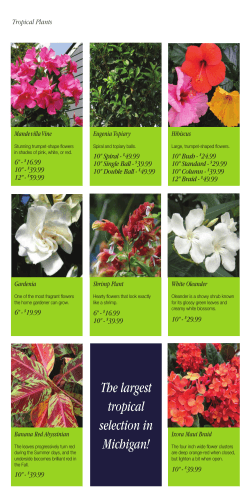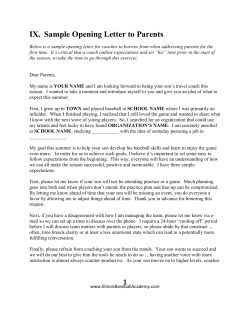
Discover the Beauty and Magic of Camellias and Azaleas at Dawson`s.
E E R F MAGAZINE! Camellias & Azaleas 2015 - 2016 ONLINE STORE NOW OPTOEN DAY! SHOP ONLINE Camellia Murchison Lady Discover the Beauty and Magic of Camellias and Azaleas at Dawson’s. www.dawsonsgardenworld.com.au DAWSON’S Camellia Collection Camellia Lady Loch Camellia Little Pearl Camellia Jennifer Susan Camellia Setsugekka Camellias have enthralled western gardeners for over three hundred years since their introduction from China and Japan. Camellias have a certain elegance that’s all their own, with handsome glossy foliage and exquisitely sculptured flowers. Dawson’s grow a tempting range of both Camellia Japonica and Sasanqua varieties, just waiting to weave their magic in your garden. Camellia availability is seasonal. Period of peak availability is usually Autumn – Spring. Check with your Dawson’s store for availability of particular varieties. Camellia Flowering Periods EARLY – Late March through to May. Camellia Hiryu By selecting a range of Sasanqua and Japonica varieties, it’s possible MID – June and July. to have Camellias flowering from March until September. Each variety LATE – August through to early September. is usually classified as flowering during one of three flowering times. Descriptions and colour pictures of Camellia varieties can be viewed at www.dawsonsgardenworld.com.au Peony Form or Informal Double Rose Form Camellia Japonica – The Classic Camellias Thought by many to be the most beautiful of the Camellias, the Japonica varieties, with their broad glossy foliage and large showy flowers, are hard to resist. There are thousands of named varieties worldwide and a fascinating range of flower forms exist from simple single flowers to exquisite waterlily-like formal double blooms. Japonica varieties grow into bushy shrubs, eventually reaching heights of around 3 metres. Most need protection from the hot Summer sun, and a position where they receive filtered light or early morning sun and afternoon shade. Camellia Japonica Descriptions (listed alphabetically) ACE OF HEARTS (JAPONICA) – Medium to large, red, semi double rose-form blooms. Bushy, upright growth. Flowers mid season. BOB HOPE (JAPONICA) – Large, semi double, dark, blackish-red blooms. Wavy petal edges. Blooms mid season. COUNTESS OF DERBY (JAPONICA) – Double flowers of rose to peony form. Creamy white to pale pink, striped with carmine. DEBUTANTE (JAPONICA) – Wonderful variety with full peony form flowers, in clear light pink. Early to mid-season flowering. DIXIE KNIGHT (JAPONICA) – Large, deep red, informal double flowers. Vigorous, upright growth. Long flowering period beginning mid season. DR CLIFFORD PARKS (RETICULATA HYBRID) Very large flowered, brilliant red blooms of loose peony form. Flowers mid-season. Released in California in 1971. DRAMA GIRL (JAPONICA) – Mid season flowering with large, semi double blooms of deep rose-pink. Upright, open grower. Prune to encourage bushy growth. Released in California in 1950. ECCLEFIELD (JAPONICA) – White, informal double blooms with wavy petals. Large flowers open to reveal a centre of showy yellow stamens. Flowers mid season. Released in California in 1959. ED COMBASTABLE (JAPONICA) – Medium sized, dark pink-red, formal double blooms. Mid-late season flowering. EDITH LINTON (JAPONICA) – Australian variety with semi double blooms of deep salmon to rosy-pink. Long flowering period. Formal Double Single Semi-Double EMPEROR OF RUSSIA (JAPONICA) – Red, informal double blooms. Flowers mid season. GRAND MARSHALL (JAPONICA) - Informal double, rich red blooms. Medium upright growth. Flowers early June –September. GREAT EASTERN (JAPONICA) – Large semi double, deep rose-red blooms. Mid to late season flowering. HELENOR (JAPONICA) – Pale pink, peony form flowers, flecked with deep pink striping. Flowers mid season. Originated in New South Wales in 1866. KATHERINE NUCCIO (JAPONICA) – Gorgeous, near perfect, rosy-red, formal double blooms. Blooms mid season. KRAMER’S SUPREME (JAPONICA) – Large, red blooms of full peony form. Mid- season flowering. LADY LOCH (JAPONICA) – Large flowered, informal double, pale pink edged with white. Flowers mid season. An Australian raised variety named in 1898. LAURIE BRAY (JAPONICA) – Near single to semi double, pale pink blooms which tend to intensify in colour as the flowers age. Petals often slightly waved, surrounding a centre of golden stamens. Flowers early to mid-season. A very reliable and much loved Australian Camellia, selected by George Linton in 1955. MAGNOLIAEFLORA (JAPONICA) – Pale pink, semi double, hose in hose style flowers. Mid season blooms. In Japan it is known as Hagoromo and can be traced back to the late 1600s. MARGARETE HERTRICH (JAPONICA) – Mid season flowering, beautiful pure white, formal double blooms. Upright, bushy grower. Released in California in 1945. MARTHA TUCK (JAPONICA) – An early season bloomer with fluted, semi double, white flowers. MOSHIO (JAPONICA) – Intense red, semi double flowers. Flowering mid season. A very old Japanese variety which has been traced back to the 1780s. MURCHISON LADY (JAPONICA) – Large, pure white, formal double blooms. Abundant mid season flowers on a medium sized, dense, upright plant. Glossy, oval shaped foliage. Originated from a chance seedling, selected by Keith Abbott, Rossmoyne, WA. NUCCIO’S GEM (JAPONICA) – A mid season flowerer with medium to large, pure white, formal double flowers. Blooms have a beautiful waterlily-like appearance. Released in California in 1970. Anemone Form PINK GOLD (JAPONICA) – Large flowered, semi double Camellia. The petals shade from pale orchid pink to deep pink tones at the margins. Centre of yellow stamens. Early to mid-season flowering. Released in 1960. PRINCE FREDRICK WILLIAM (JAPONICA) – An Australian raised variety which first appeared in a Parramatta nursery in 1872. Perfect, formal double, mid- season, rose pink blooms. Beautiful layered, overlapping petals. THE CZAR (JAPONICA) – One of the most widely grown Camellias in Australia. Blooms mid season, producing large, semi double, light crimson flowers. WHITE NUN (JAPONICA) – One of the largest white flowering Camellias. Massive, pure white, semi double blooms from mid-season. Released in California in 1959. Camellia Sasanqua – The Autumn Flowering Camellias Sasanqua Camellias differ from the Japonica varieties in that they flower earlier, have smaller and more elongated foliage and are often taller, more open and spreading in habit. Sasanquas start the Camellia flowering season in spectacular style, with varieties flowering between March and July. They generally grow to 1.5 to 3-4 metres in height. Favoured planting positions are sheltered semi shaded sites or east facing aspects offering morning sun and afternoon shade. They can also be grown in full sun positions, provided they are watered daily during the warmer months and a thick layer of moisture conserving mulch is applied. Sasanquas are wonderful shrubs in their own right, but really come into their own when used for hedges, screening and espalier and also make ideal container plants when potted into large pots and tubs. Camellia Sasanqua Descriptions (listed alphabetically) BEATRICE EMILY* (SASANQUA) – Double, creamy white with the outer petal edges tinted lavender. Early season flowering. BONANZA* (SASANQUA) – Large, semi double, peony style blooms of deep cerise-red. Early season flowering. COOLGARDIE STAR* (SASANQUA) – Early Flowering, pure white, semi-double flowers which are delicately perfumed. A vigorous, upright plant, bred in WA. * Denotes sun tolerant varieties – ensure plenty of water and mulch is provided over the warmer months. DAY DAWN BELLE* (SASANQUA) – Dense, upright grower with small, rosy pink, semi-double to rose form blooms. Originated by Keith Abbott, Rossmoyne, WA. Early to mid-season flowering. EARLY PEARLY* (SASANQUA) – Large flowered, pearly-white formal double blooms. Flowering early to mid-season. FUKUZUTSUMI* (SASANQUA) – Large, single flowers of soft white, flushed with pink. Early season flowering. HIRYU* (SASANQUA) – Single to semi double, deep cerise flowers, with petals showing a lighter shade at the base and centre of the bloom. JEAN MAY* (SASANQUA) – Shell pink semi double flowers. Early- season flowering. JENNIFER SUSAN* (SASANQUA) – Early season blooms of soft pink, in semi double peony form. LITTLE PEARL* (SASANQUA) – Light pink buds open to pure white semi double blooms. Compact grower, well suited to containers. DAWSON’S LUCINDA* (SASANQUA) – Early season flowerer, with soft rose-pink, semi double blooms. MARGE MILLER* (GROUNDCOVER SASANQUA) – The first ever, groundcover sasanqua. Double pink blooms from early to mid-season. Fantastic in pots or baskets or when used as a groundcover in semi shade areas. Height to 30cm, width 1-1.5m. MARIE YOUNG* (SASANQUA) – Pretty, single, pale pink blooms. Early to mid-season flowering. MINE-NO-YUKI* (SASANQUA) – Double, pure white flowers. Early season flowering. PLANTATION PINK* (SASANQUA) – Large single flowers of soft pink, slightly cupped in shape. PURE SILK* (SASANQUA) – Semi double blooms of pure white. Early to mid-season flowering. SHISHI GASHIRA*(SASANQUA) - Medium sized, semi double to near double, rosy-red blooms. Prolonged flowering over late season. Compact spreading grower, ideal for tubs, espalier work or low hedges. SNOW* (GOUNDCOVER SASANQUA) – A sport of Marge Miller. Snow is the first white flowering groundcover Sasanqua. Double white blooms from early to mid-season. Fantastic in pots or baskets or when used as a groundcover in semi shade areas. Height to 30cm, width 1-1.5m. SNOW CLOUD* (SASANQUA) – Tall, semi double, white flowers with a hint of pale pink. Tall, rapid growing plant. Early to mid-season flowering. ROSE ANN* (SASANQUA) – Deep rose pink, semi double flowers. Early season flowering. STAR ABOVE STAR* (SASANQUA) – Semi double blooms with pink blush on petal edges. Early season flowering. SETSUGEKKA* (SASANQUA) – Single, pure white blooms, with a prominent centre of golden stamens. YULETIDE* (SASANQUA) – Glowing red single flowers are borne early to mid-season. Orange Delight Dogwood White Red Wing Azalea Collection Azaleas are amongst the most popular, evergreen shrubs we grow. Much loved for their abundance of flowers. Azaleas are recommended for mass planting beneath deciduous trees, bedding plants for filtered light situations, and perfect planting partners for Camellias in Camellia and Azalea gardens, and Japanese gardens. They make a natural choice for tubs and planters, and smaller varieties can even be grown in hanging baskets. The majority of Azaleas will grow best in sheltered, filtered light situations. There are however some that are more sun tolerant and these are marked with an asterisk (*) following their name in the list. Azalea availability is seasonal. Period of peak availability is usually Autumn-Spring. Check with your Dawson’s store for availability of particular varieties. Azalea Flowering Periods EARLY – Late March through to May. By growing a range of Azalea varieties, it’s possible to have plants flowering from March until November. Each variety is usually classified as flowering during one of three flowering times. MID – June and July. LATE – August through to early September. Descriptions and colour pictures of Camellia varieties can be viewed at www.dawsonsgardenworld.com.au Single Hose-in-Hose Semi-Double Hose-in-Hose Azalea descriptions (listed alphabetically) ALBA MAGNA* – Tall growing variety, with large, single white blooms. Slightly scented, mid season flowerer. Double Hose-in-Hose Single RED WING* – Popular variety with bright red, semi double, hose in hose flowers. Growing to medium height, flowering in mid season. GOYET* – Tall grower, with large, brilliant red, double flowers. Flowering mid to late season. ROSE QUEEN – Delightful, bright pink flowers. Early season flowerer, growing to medium height. HAPPY DAYS* - Light purple, hose-in-hose flowers. Tall growing. Flowers mid season. Developed by Nuccio’s Nurseries of Altadena, California. BLUE MOON – Late flowering variety with single, lavender blue flowers. Ideal low hedge. HONEY BUNCH – White, hose in hose type flowers, blending into deep salmon pink on the edges and tips. Mid season flowerer. DOGWOOD PINK – Small shrub, with single pink flowers, streaked with white. Mid- season flowerer. DOGWOOD RED – Single, red flowers in mid season. Growing to medium height. DOGWOOD WHITE – Single, pure white flowers in late season. Medium sized bush. Double FRED COLBERT* - Early season flowering with red, semi-double hose in hose, style blooms. Medium height. ALPHONSE ANDERSON* – Large, single pink flowers of soft pink, edged white, with a deep rose throat. Tall growing, mid season flowerer. CHARLY – Low growing with large cerise-red flowers. Flowers early season. Semi-Double Azalea Goyet ROSE KING – A sport of Rose Queen with deeper rose-pink blooms. Medium sized grower, flowering early to mid-season. SCARLET GEM – Late flowering variety with bright red hose in hose flowers. Medium height. KIRIN – Compact, small shrub, covering itself with small, rosy pink, blooms. STARLIGHT – Medium sized grower, with double, pale salmon pink flowers in early season. Semi-Double. LUCI – Bright pink, double flowers. Low grower with extended flowering period. SWEET SIXTEEN – Early flowering, double pale pink, frilly blooms. MRS KINT WHITE – Single white flowers, on a low growing, compact bush. TEMPERANCE – Fully double, pale mauve flowers. Medium growing and flowering early season. ONLY ONE EARTH – Semi-double blooms of glowing cerise-red. Small, compact grower. Early flowering. ELSA KARGA* – Double, glowing red blooms. Medium height. ORANGE DELIGHT* – Stunning late season flowerer, with large single orange blooms. Medium height. EXQUISITE* – Tall growing variety with single, pink flowers with a red throat. Mid- season. PHOENICEA* – Tall growing, mid season flowering variety. Large, single, violet-rose flowers. FIELDERS PINK* – Single pink flowers on a tall growing, late flowering bush. PURPLE GLITTERS* – Single glowing purple blooms. Compact, small to medium shrub. FIELDERS WHITE* – Large, single, white scented blooms, with green throat shadings. Tall, late flowering variety. PRINCESS SHARON – Seme double to double, finely sculptured blooms of pure white. Medium sized grower. Early-Mid season flowering. VIOLACEA – Double, violet-purple flowers. Medium sized grower, flowering early season. WHITE BOUQUET – Large, semi double flowers with a green throat. Medium height grower. Long flowering period mainly autumn to spring. Will often surprise by flowering at other times of the year. WHITE CLOUD – Bushy, medium sized plant. Double white flowers. Early season flowering. WHITE PRINCE* – Early flowering, semi double white flowers with a red throat. Medium sized grower. * Denotes sun tolerant varieties - ensure plenty of water and mulch is provided over the warmer months. Dawsons expert growing tips for success with Camellias and Azaleas. Camellia Plantation Pink Camellia Kramer’s Supreme Camellia Fukuzutsumi Camellia Murchison Lady Pests & Diseases Camellias: Camellias are generally trouble-free, however on rare occasions you may find one of the following: Getting the Soil Right Growing in Pots One of the real keys to successful Camellia and Azalea growing in Perth, is proper soil preparation before planting. These plants are acid soil lovers, so in Perth’s limey sands it’s all important to improve the planting soil with generous amounts of acidic-organic matter. Camellias and Azaleas have naturally shallow root systems, so they make ideal container plants and look particularly attractive in glazed pots. For best results use Dawson’s Garden World Premium Potting Mix. Avoid using cement pots, as lime from the cement will cause problems. Elevate pots to ensure good drainage of excess water and don’t sit pots in saucers. Remember container grown plants dry out three times faster than those in the ground. So, regular even daily watering is required over the warmer months. Controlled (slow) release fertilisers are the best and safest option for feeding container grown plants. Supplement this with a fortnightly liquid feed with Seasol, a great nutrient packed health tonic for plants. An easy way to do this is to blend in Dawson’s Organic Soil Improver at the rate of 2 parts Soil Improver to 2 parts existing soil (50:50 mix). If soil is too limey (alkaline), it will show up in pale or yellowish foliage, often with brown-black spots along the edges. The time spent undertaking good soil preparation is a great investment in your plant’s health. Planting in the Garden Camellias and Azaleas can be planted throughout the year, provided regular, daily watering is provided during the vital establishment period. 1.Choose a planting spot with free draining soil and preferably with protection from strong winds. 2.Before planting, thoroughly water the plant in its pot. 3.At the selected planting site, dig a hole three times the width of the pot and twice the depth of the pot. 4.Blend in Dawson’s Organic Soil Improver at the rate of 2 parts Soil Improver to 2 parts existing soil (50:50 mix). Make sure Soil Improver is well mixed in with existing soil. 5.Mix in 1 tablespoon of a suitable Controlled Release fertiliser. 6.Return about ¼ of the improved soil mixture to the bottom of the planting hole. 7.Remove the plant from its pot and plant no deeper than the original soil level in the pot. 8.Back-fill the planting hole with the rest of the improved soil mixture. 9.Gently firm soil around the plant and thoroughly water to exclude any air pockets. Use at least 10 litres of water per plant. 10.Newly planted Camellias and Azaleas will require daily watering until well established, this is particularly important over the warmer months. Liquid feed fortnightly with Seasol to help stimulate root growth. Watering Camellias and Azaleas have a naturally shallow root system and enjoy a cool root run. They need a regular supply of water, especially over the summer months. An annual application of a soil wetting product in spring each year, will greatly assist water penetration. Or for a more permanent fix try mineral clay based soil builders like Soil Solver. Newly planted Camellias and Azaleas will require daily watering until established, this is particularly important over the warmer months. Well mulched established plants will survive happily on 2-3 deep soaks a week. In extreme heat, extra watering is very beneficial. Mulching Mulch around plants with a coarse grade mulch like Waterwise Pine Bark Mulch, leaving a 10-15cm bare circle around the main stem. Feeding Camellias & Azaleas The best time to fertilise garden plants is in Spring, just after flowering and again in early Summer when plants are making most of their growth. Feed with a specific Azalea and Camellia Fertiliser or Dawson’s All Purpose Garden Fertiliser. Always apply fertilisers to moist soils, apply at recommended rates and water in well. Keep in mind that these plants are shallow rooted and too much fertiliser can cause burning. An application of Sulphate of Potash when flower buds are developing in February will help improve flower size and quality. A fortnightly liquid feed with a combination of Seasol and Powerfeed, is a great addition to your Camellia feeding program. This combination provides all the nutrients required for healthy plant growth. Forrestfield: 170 Hale Road Ph 9453 6533 Joondalup: 179 Winton Road Ph 9300 0733 O’Connor: 388 South Street Ph 9314 7258 Swanbourne: 153 Railway Street Ph 9384 9652 • Scale - spray with Eco Oil*. •A phids - simply hose off with strong water jet, or spray with Eco Neem*, Eco Oil* or Natrasoap*. •C aterpillars - attacking new growth, spray with Success. • Mealy bug - spray with Confidor* or Eco-Oil*. •R ed Spider Mite - Spray with Mavrik*, Natrasoap*, Eco Neem* or Eco-Oil* Spray twice, two weeks apart, to bring mite populations under control. Predatory Mites can also be ordered from your nearest Dawson’s store. Predatory mites feed on spider mites, offering a natural way to control spider mites in your garden. For more information inquire in-store or see a Predatory mite fact sheet on www.dawsonsgardenworld.com.au Azaleas: Common pests and diseases are: •R ed Spider Mites - refer to Camellia section for further information •L ace Bugs and Thrips - all causing silvering of the leaves. Thrips and Lace Bugs also leave tell-tale, brown/black specks on the leaves. •L ace Bugs - Spray with Confidor* or apply Confidor Tablets. • Thrips - spray with Confidor or Natrasoap*. • P etal Blight - a fungal disease, causing flowers to turn brown and mushy. Spray with Mancozeb Plus*or Zaleton*. Begin spraying at the expanded bud stage (before buds begin to colour) until the end of flowering. •L eaf Tip Burn - If leaves turn brown at the tips - the problem could be poor drainage, incorrect pH, too dry, over fertilising or wind burn. *During the warmer months don’t spray during the heat of the day, or when temperatures exceed 35ºC. Your Guarantee of Quality Because Dawson’s Garden World grows the plants we sell, we can confidently offer a FREE REPLACEMENT PLANT* if, for any reason, any Dawson’s plant fails to perform. *Original sales receipt or Dawson’s price label required as proof of purchase. Need more gardening advice and information? Just ask any of our friendly staff at your local Dawson’s Garden World. Fax 9453 9520 Fax 9300 1244 Fax 9314 7264 Fax 9383 2108 Email: askdawsons@dawsonsgardenworld.com.au www.facebook.com/dawsonsgardenworld for more great ideas www.dawsonsgardenworld.com.au A WORLD OF PLANTS GUARANTEED TO GROW A WORLD OF KNOWLEDGE OPEN EVERY DAY (except Christmas Day) 8.30am - 5.30pm
© Copyright 2025









